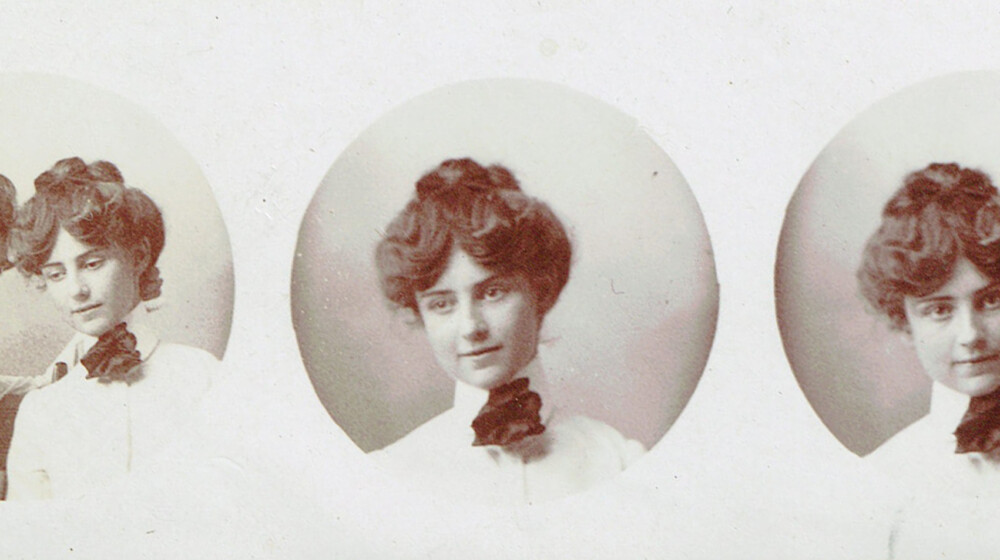Rumors and Speculation
Did you know…
(Before we start, we would like to thank everyone who has supported us during this time, and who continue to do so with their purchases, donations, and memberships. Your care for this valuable and vulnerable piece of local history means the world to us. Thank you!)
Believe it or not, we historians are not always right. We admit it! History is as complex as the lives of the people who live it, and since people don’t write down every thought they have or action they take, we have to make an educated guess about what actually happened and why. We look at primary and secondary sources whenever possible – through letters and journals if we’re lucky, and through newspaper and document archives – to learn more about the people and times we’re studying.

Oh, the horror of microfiche. Better take your motion sickness pills before you get started!
Raise your hand if you remember having to go through dusty documents themselves, or copies on microfiche at your local library! We do, and consider ourselves extremely lucky to have online resources like the Digital Arizona Library, the Maricopa County Recorders Office, the Library of Congress, Newspapers.com, Ancestry, and more to help us delve into historical archives. Previously, if we wanted to see the original deed that transferred ownership of the Rosson House from the Rossons to the Goldbergs, we’d have to go get in our cars to go to the County Recorders Office in person, fighting Phoenix traffic on the way – that in and of itself reason enough to dread the trip! Now, it can be done with a simple online search that takes a minute or two, from the comfort of our couch. It is unquestionably easier.
Ease of access and using primary sources doesn’t always mean reported histories are 100% accurate, though. Mistakes can happen when trying to decipher old handwriting, exact dates can be misremembered or jumbled, and rumors and myths can be given the weight of truth without real evidence to back them up. Perspective can be powerful, and biases for or against something, whether from historians themselves or from whoever recorded the history to begin with, do happen.

The Rosson House, circa 1967.
While researching Rosson House in the more recent Arizona Republic archives, we’ve come across an interesting statement about Flora Murray Rosson (pictured at the top of the page) from an article in the August 20, 1967 newspaper. The article, which calls the house the Whitelaw Reid Home after its most famous snowbird resident, says this about Flora:
“Mrs. Rosson dreamed of living with panache in Arizona Territory. She wanted a home like “back East,” with room to entertain. (The Rossons) moved to Los Angeles in 1896, (where Dr. Rosson) died a year later, with rumor whispering he was a suicide, despondent over his wife’s burning ambitions and lavish spending.”
Interesting! No punches pulled here! However, for starters, the article gets a couple of dates about the Rossons wrong, including the year the House was built – the article says 1892, but we know work started in 1894 and finished in 1895 – and the year the Rossons moved to California, which actually happened in 1897. But what about what the article says about Flora? We hadn’t heard this rumor, but could what it says about her be true? We looked for more evidence and found it…Kind of.
This story about Flora being a social climber was repeated in the National Registry of Historic Places Nomination Form in 1971 (referencing the 1967 article). Also, a document from the Murray-Rosson family history deep in our files (provided by members of that family), says that the family, “Never believed (Dr. Rosson) committed suicide after three weeks illness over his ‘wife’s burning social ambitions and lavish spending’.” Though it’s not dated, could this be where the story from the 1967 article came from? Or is this a reaction to the 1967 article? Since we don’t have journals or letters from the Rossons, or any other first-hand accounts, we have to rely on evidence from newspapers, and general knowledge about the time period and the people involved.

An 1894 newspaper article about a social gathering in Tempe.
When Roland and Flora lived in Phoenix during the late 1800s, social gatherings were regularly mentioned in newspapers. Information about parties included who gave them, who attended them, decorations, games or other activities, and even occasionally what women wore. Common sense tells us that anyone with, “burning social ambitions,” would have been mentioned often, as both host and attendee. Big purchases, like pianos, automobiles (after 1900), houses, or lavish and lengthy vacations, were also mentioned in the newspaper.
So, was Flora Rosson in the newspaper all of the time as part of the social set, wearing expensive new gowns? Did she purchase a fancy piano and top of the line furnishings to go in their new house? Did she vacation on the Riviera, or even just on the beach in California? Here are Heritage Square Museum Interpreter, Katie Delahoyde, and Director of Education, Jennifer Hance, to give us the inside scoop:
-
Katie Delahoyde, Museum Interpreter
Surely everyone knows that only an “ambitious social climber” would’ve joined the Golden Leaf Croquet Social Club in 1879! Or perhaps 20-year-old Flora Murray was just bored and wanted to spend time with other young people. In my opinion, it’s impossible to know whether Flora Murray Rosson was a “social climber” with the information we have.
We know Flora experienced hardships. She was about 10 when her mother died and 12 when her father followed, a brother-in-law was murdered, she is known to have lost two babies, and she was widowed at 39. We also know her family had plenty of successes. The Murray family owned a fair bit of real estate, Flora was able to attend school and was noted for her oratory in the newspaper, her sister Marilla was one of the Valley’s first teachers and mother to a governor, her sister Anna was married to the first mayor of Phoenix, and her own husband was (briefly) mayor as well. Dr. and Mrs. Rosson appear to have had some financial difficulties toward the end of their time in Phoenix, but the Rosson family seems to have lived comfortably but not outrageously in Los Angeles (excluding Dr. Rosson, who died shortly after moving to the city).
It’s possible that Jeanne Tro Williams, the Arizona Republic reporter, had access to sources we don’t today. When she wrote her article in 1967, it had only been 70 years since the Rossons had left for Los Angeles. There were surely people left in Phoenix who had known the family, and, indeed, some of the Rosson children were still alive. Sometimes historical information is lost and then rediscovered, even within the archives of a museum. Perhaps a cache of letters or a recorded interview will turn up explaining this notion that Flora Rosson was a social climber or a spendthrift. Until that happens, nothing we have suggests she was anything on par with, say, Alva Vanderbilt.
-
Jennifer Hance, Curator of Collections
I don’t think we know whether Flora was a social climber or not, but in my opinion, it doesn’t seem likely. First, her choice of husband: While Roland certainly was a handsome, well-liked man, he wasn’t a great catch socially. He wouldn’t have any money of his own. He was from a poor part of Virginia and a poor family (his father is listed in the 1850 census as a tailor), and you don’t get rich in the Army. He had a dubious reputation having been dishonorably discharged, although that didn’t seem to bother too many people. I suspect that Flora was anxious to get out from under her sisters’ control and have a home of her own. She was orphaned at young age and was shuttled between her older married sisters until she grew up and got married herself. I can see that being wearing.
Second, I don’t believe she was a social climber because she doesn’t get mentions in the newspapers for entertaining. Newspapers at the time reported everything about everybody. If you had a party, the paper would report who came, what they wore and what you served. The absence of this kind of reporting makes me think she didn’t entertain. Finally, she lived in an adobe house for 14 years. After the flood of 1891, people were reported as saying at least those horrible adobe houses are gone. While perfectly suited to AZ if well maintained, I think adobe was looked down upon by easterners.
I don’t think it a coincidence that the Rossons built their house at the same time he was running for mayor. My guess is that Roland was the one with his sights on something more.
Where did this story come from? I think people put together the partial facts that they know and draw conclusions that may be inaccurate. It’s easy to do. The story of social climbing Flora predates all the excellent research that people like Vicki Beaver did in the 1970s as the house was being restored. I haven’t seen the story repeated since then. Unfortunately, they didn’t leave letters that would give them insights into their own thoughts. Why couldn’t she have kept a diary!?! Then, we’d know for sure.
No lavish spending that we could find, not many parties, marrying “down”, waiting for years to build a fancier, European-style home, and not one mention of her going crazy with the insurance money (or any mention of her at all) after her husband’s death. What do you think about Flora? Can this rumor about her being a social climber and spendthrift be confirmed, or is it busted?
Find out more about Dr. Rosson’s story — including his dishonorable discharge and the mystery surrounding his death — in our blog from September 2017.
Archive
-
2024
-
October (1)
-
September (1)
-
August (1)
-
July (1)
-
June (1)
-
May (1)
-
April (1)
-
March (1)
-
February (1)
-
January (1)
-
-
2023
-
December (1)
-
November (1)
-
October (1)
-
September (1)
-
August (1)
-
July (1)
-
June (1)
-
May (1)
-
April (1)
-
March (1)
-
February (1)
-
January (1)
-
-
2022
-
December (1)
-
November (1)
-
October (1)
-
September (1)
-
August (1)
-
July (1)
-
June (1)
-
May (1)
-
April (1)
-
-
2021
-
December (1)
-
November (1)
-
October (1)
-
September (1)
-
August (1)
-
July (1)
-
June (1)
-
May (1)
-
April (1)
-
March (1)
-
February (1)
-
January (1)
-
-
2020
-
December (1)
-
November (1)
-
October (1)
-
September (1)
-
August (1)
-
July (1)
-
June (1)
-
May (1)
-
April (1)
-
March (1)
-
February (1)
-
January (1)
-
-
2019
-
December (1)
-
November (1)
-
October (1)
-
September (1)
-
August (1)
-
July (1)
-
June (1)
-
May (1)
-
April (1)
-
March (1)
-
February (1)
-
January (1)
-
-
2018
-
December (1)
-
November (1)
-
October (1)
-
September (1)
-
August (1)
-
July (1)
-
May (1)
-
April (1)
-
March (1)
-
February (1)
-
January (1)
-
-
2017
-
December (1)
-
November (1)
-
October (1)
-
September (1)
-
August (1)
-
July (1)
-
June (1)
-
May (1)
-
April (1)
-
March (1)
-
February (1)
-
January (1)
-
-
2016
-
December (1)
-
-
2015
-
2014
-
July (1)
-
